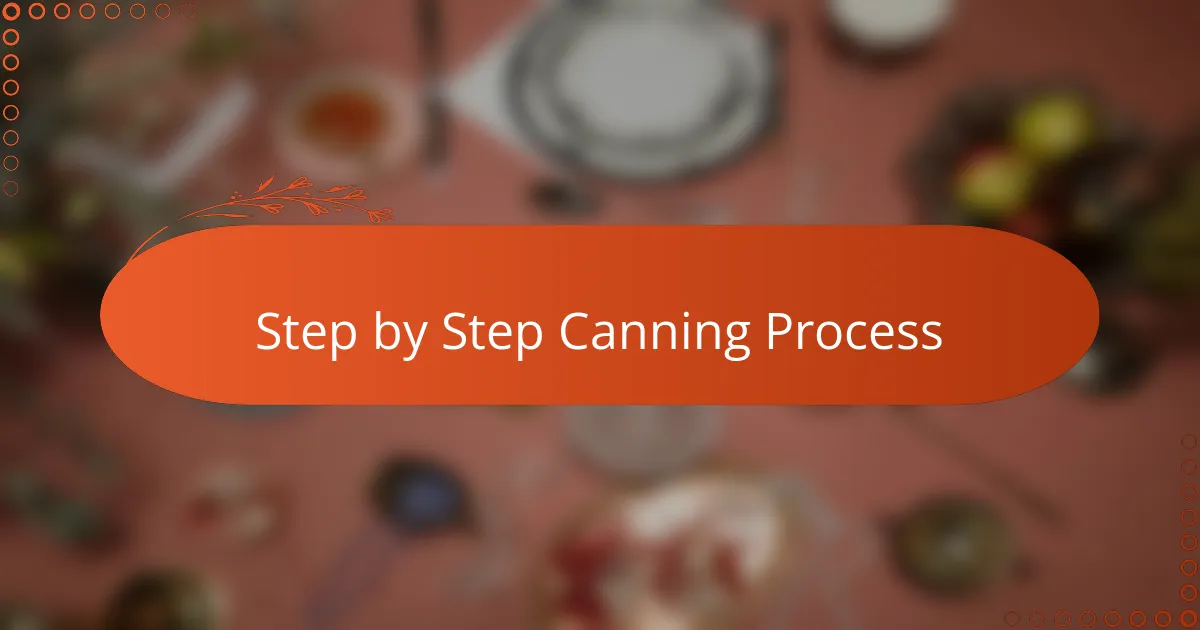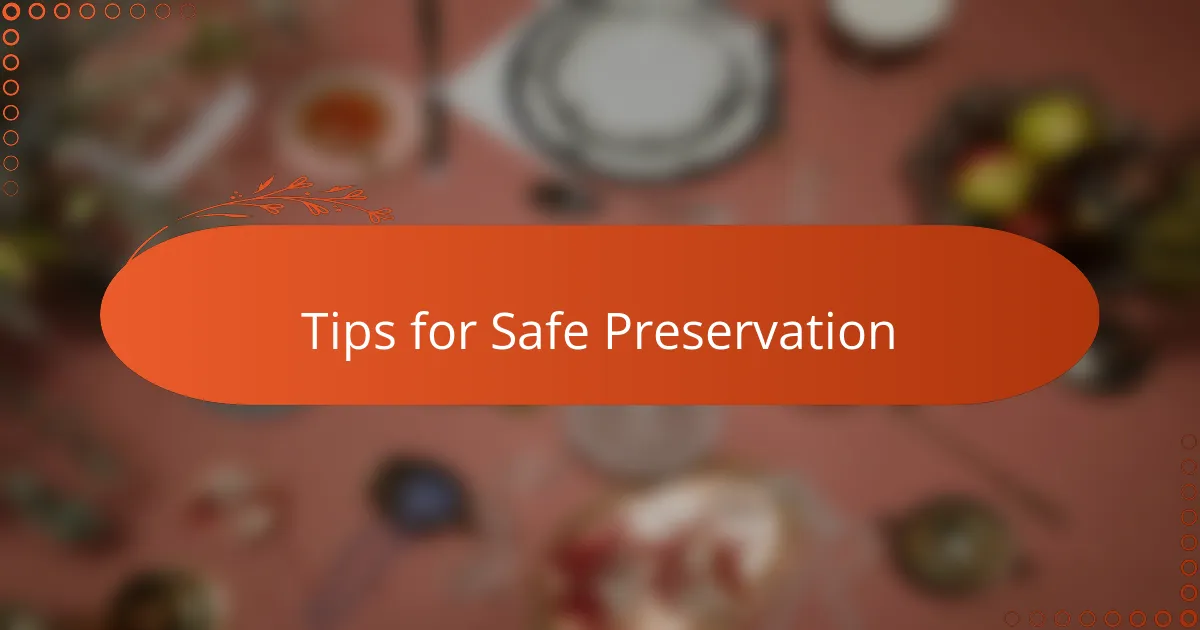Key takeaways
- Apple butter canning preserves the rich, concentrated flavor of homemade apple butter, allowing enjoyment beyond the apple season.
- Essential equipment for successful canning includes a water bath canner, new canning lids, jars, a jar lifter, and a funnel for safety and efficiency.
- Key steps in the canning process involve keeping everything hot, allowing proper headspace in jars, and ensuring seals are tight but not over-tightened.
- Experimenting with flavors like bourbon or spices can create unique variations of apple butter, enhancing the traditional recipe.

What Is Apple Butter Canning
Apple butter canning is the timeless method of preserving homemade apple butter in sterilized jars, allowing you to enjoy that rich, spiced spread long after the apple season ends. When I first tried it, the process felt like capturing autumn in a jar—each seal held a piece of the season’s warmth.
Have you ever wondered why apple butter has such a deep, concentrated flavor compared to regular applesauce? That’s because the slow cooking and reduction remove excess moisture, intensifying the sweetness and spices before sealing it safely through canning.
From my experience, nothing beats the satisfying “pop” sound when opening a jar of properly canned apple butter; it’s like unlocking a little treasure made with patience and care. This preservation technique isn’t just about storage—it’s about savoring tradition and homemade goodness whenever you want.

Essential Equipment for Canning
When I first gathered my gear for canning apple butter, I quickly realized that having the right equipment makes all the difference. A sturdy water bath canner was my first must-have; without it, achieving that perfect, airtight seal felt almost impossible. Have you ever tried using a regular pot? It usually results in jars that just won’t seal properly, and that can be so frustrating.
Another tool I couldn’t live without is a good set of canning jars with new lids. I learned early on that reusing old lids often leads to failure in sealing, which defeats the whole purpose of preserving your apple butter. Plus, using a reliable jar lifter and funnel not only keeps things safe and sanitary but also makes the whole process smoother—especially when your hands are sticky from all that delicious apple goodness.
Lastly, I found that a kitchen timer and a clean cloth are small but essential companions in the kitchen. The timer keeps me focused on the exact processing time, preventing under or over-cooking. The cloth helps wipe the jar rims clean before sealing, ensuring no stray bits interfere with the seal. Have you ever tried skipping these little steps? I’ve learned they might seem minor, but they can make or break your batch.

Step by Step Canning Process
Once I had all my gear ready, I dove into the actual canning steps, and honestly, it felt like a ritual. First, I filled my water bath canner with water and heated it to a gentle boil—this preps the jars so they don’t crack from the hot apple butter. Have you noticed how important it is to keep everything hot and ready? It helps everything flow smoothly and keeps spoilage at bay.
Next came the filling part, which always makes me a bit nervous. Using a funnel to ladle the steaming apple butter into each jar, I left just the right amount of headspace—usually about a quarter-inch—to allow the butter room to expand during processing. Then, with a damp cloth, I wiped each jar’s rim clean; I can’t stress enough how this small step saved me from those pesky seal failures that I once learned the hard way.
Finally, sealing the jars tightly but not over-tightened, I lowered them into the boiling water bath and let them process for the recommended time. Waiting for those jars to “pop” later became my favorite moment—proof that patience and careful steps really pay off. Have you ever experienced that little thrill when a jar seals properly? It’s like a quiet celebration of all that effort turned into something lasting.

Tips for Safe Preservation
One thing I’ve learned is that using fresh lids every time makes a world of difference in safe preservation. I used to save lids from previous batches, thinking it was fine, until I found a jar that didn’t seal and spoiled my entire batch—what a lesson in diligence! Have you ever faced that frustration of opened jars gone bad? It truly underlines why fresh lids aren’t just a suggestion; they’re a must.
Another key tip is ensuring your jars are spotless and free from cracks or chips before filling. I once skipped a close inspection and ended up with a jar that cracked during processing—nothing like losing a full jar of apple butter and dealing with glass shards to teach you the importance of quality control. Keeping everything hygienic and intact isn’t just about safety; it protects all the hard work you put into your apple butter.
Finally, paying close attention to processing times in the boiling water bath is critical. I remember rushing the process on an impatient day and regretting it when the seals didn’t hold. Have you ever wondered why the recommended timing is so strict? It’s because proper heat exposure kills harmful bacteria, ensuring your apple butter stays delicious and safe for months. Trust me, patience here makes all the difference.

Common Challenges and Solutions
One challenge I often face when canning apple butter is getting a proper seal on every jar. Early on, I remember the sinking feeling of opening a jar only to find it hadn’t sealed correctly, turning my batch into a race against time to consume or discard. Have you ever had jars fail to seal? From my experience, carefully wiping the jar rims and using fresh lids each time drastically reduces this frustrating problem.
Another hiccup that caught me by surprise was the thick consistency of apple butter causing air bubbles and uneven sealing. I learned that after filling the jars, running a non-metallic spatula around the inside helps release trapped air, which makes a big difference. Plus, being patient with the water bath timing is crucial—I once rushed it, and the jars didn’t preserve as well, which was really disappointing.
Sometimes, the sheer length of the cooking and canning process can feel overwhelming. I’ve found that breaking the steps into manageable tasks, like preparing jars first and then focusing fully on the apple butter, keeps me motivated and reduces mistakes. Have you tried pacing yourself this way? It transforms the process from a chore into a peaceful kitchen ritual.

Personal Experience with Canning
Canning apple butter was a bit intimidating the first few times I tried it. I remember standing by the stove, watching the jars in the boiling water, my heart pounding a little with the hope that each would seal properly. That moment of uncertainty mixed with excitement is something I think anyone who cans can relate to.
One time, I rushed through the process and skipped wiping the jar rims thoroughly. Needless to say, a couple of jars didn’t seal right, and I learned the hard way that patience and careful cleaning are absolutely worth it. Have you ever made a simple oversight like that? It really drives home how these small steps matter.
Over the years, the routine has become comforting—each batch feels like a personal achievement and an act of love preserved for months ahead. There’s something deeply satisfying about knowing that my family will open a jar in the winter and taste the essence of autumn harvested straight from my kitchen. Doesn’t that feeling make all the effort worthwhile?

Recipe Variations to Try
If you’re feeling adventurous, why not try adding a splash of bourbon or a hint of maple syrup to your apple butter before canning? I did this once during a chilly fall weekend, and the subtle warmth it added made the jars vanish faster than I expected at family breakfast. It’s amazing how a small twist can breathe new life into a classic recipe.
Sometimes I like to experiment with spices beyond the traditional cinnamon and cloves. Adding a pinch of cardamom or a little fresh ginger can transform the flavor profile and keep things exciting from jar to jar. Have you ever caught yourself craving something familiar but with a surprising kick? These variations can satisfy that perfectly.
For those who prefer a chunkier texture, I’ve found blending only half of the cooked apples and leaving the rest in small pieces creates a lovely contrast. It feels like rediscovering apple butter all over again — smooth and hearty in one delicious bite. It’s a simple change that made me appreciate apple butter’s versatility in so many dishes.



